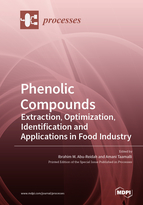Phenolic Compounds: Extraction, Optimization, Identification and Applications in Food Industry
A special issue of Processes (ISSN 2227-9717). This special issue belongs to the section "Food Process Engineering".
Deadline for manuscript submissions: closed (31 December 2020) | Viewed by 65218
Related Special Issue: Secondary Metabolites: Extraction, Optimization, Identification and Applications in Food, Nutraceutical, and Pharmaceutical Industries
Special Issue Editors
2. Core Science Facility, Memorial University of Newfoundland, St. John’s, NL A1B 3X5, Canada
Interests: phytochemicals; functional foods; natural products; plant biodiversity; medicinal plants; food plants; bioactivity; polyphenols; flavonoids; secondary metabolite profiling
Special Issues, Collections and Topics in MDPI journals
Interests: natural products; phytochemicals; functional foods; biodiversity; medicinal plants; food plants; bioactivity; polyphenols; flavonoids; secondary metabolite screening
Special Issue Information
Dear Colleagues,
We are pleased to invite you to submit original articles to the Special Issue entitled “Phenolic Compounds: Extraction, Optimization, Identification, and Applications in the Food Industry”.
Interest has grown around natural plant extracts in food and beverage applications, their role in food technology, quality, and their therapeutic use in inhibiting several diseases. The protecting effects of healthy diets rich in fruits, vegetables, and whole grains are due not only to fiber, vitamins, and minerals, but also to a diversity of plant secondary metabolites, in particular, phenolic compounds, which are considered among the most important classes originating in plant-derived secondary metabolites. Phenolic compounds are considered among phenolics and are renowned for their possession of a wide array of remarkable biochemical and pharmacological properties, including antioxidant, antiviral, anticancer, and anti-inflammatory activities. Consequently, these compounds can be functional in the prevention of many diseases as well as in health maintenance, in addition to phenolics-varied applications in the nutraceutical, food, and pharmaceutical industries, and due to their importance in the pharma- and nutraceutical arenas. This Special Issue aims at gathering together the most recent contributions concerning their chemistry, extraction methods, and analytical techniques, along with their biological activities. The interpretation of phenolic bioactivities in a molecular basis by means of both well-established and advanced bio-analytical techniques is also greatly welcome.
We would like to invite researchers to participate in this Special Issue by submitting a contribution in their field of expertise. Both original research papers and global or specialized critical reviews are welcome.
Potential topics include but are not limited to the following:
- Advanced analytical methodologies for the isolation, purification, and analysis of phenolics from food, food wastes, and medicinal plants;
- Phenolic compounds and metabolites in plants, food, and biological samples;
- Biological activities and mechanisms of action;
- Health benefits, in vivo evaluation;
- Development of novel antioxidants and phenolics-based nutraceuticals and functional ingredients.
Dr. Ibrahim M. Abu-Reidah
Dr. Amani Taamalli
Guest Editors
Manuscript Submission Information
Manuscripts should be submitted online at www.mdpi.com by registering and logging in to this website. Once you are registered, click here to go to the submission form. Manuscripts can be submitted until the deadline. All submissions that pass pre-check are peer-reviewed. Accepted papers will be published continuously in the journal (as soon as accepted) and will be listed together on the special issue website. Research articles, review articles as well as short communications are invited. For planned papers, a title and short abstract (about 100 words) can be sent to the Editorial Office for announcement on this website.
Submitted manuscripts should not have been published previously, nor be under consideration for publication elsewhere (except conference proceedings papers). All manuscripts are thoroughly refereed through a single-blind peer-review process. A guide for authors and other relevant information for submission of manuscripts is available on the Instructions for Authors page. Processes is an international peer-reviewed open access monthly journal published by MDPI.
Please visit the Instructions for Authors page before submitting a manuscript. The Article Processing Charge (APC) for publication in this open access journal is 2400 CHF (Swiss Francs). Submitted papers should be well formatted and use good English. Authors may use MDPI's English editing service prior to publication or during author revisions.
Keywords
- phytochemical characterization
- pharmacological activity
- fingerprint
- secondary metabolites
- liquid and gas chromatographies
- mass spectrometry
- analytical methods
- phenolics
- bioactive compounds
- functional ingredients







